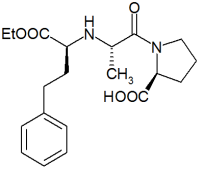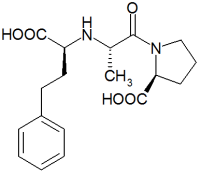USE THIS I.V ANTIHYPERTENSIVE DRUG FOR PRE BLOOD PRESSURE CONTROL
Mechanism of action: Enalaprilat (Vasotec I.V.) inhibits angiotensin-converting enzyme (ACE), preventing the conversion of angiotensin I to angiotensin II. This leads to vasodilation and decreased aldosterone secretion, decreasing blood pressure, preload, and afterload.
Indications: For mild to severe hypertension when oral therapy isn't practical.
Dosage (adults): For patients not receiving diuretics, administer 1.25 mg slow intravenous (I.V.) infusion over at least 5 minutes every 6 hours. For patients receiving diuretics, give 0.625 mg over at least 5 minutes, repeat in 1 hour if needed, then give 1.25 mg I.V. every 6 hours. Alternative: Enalaprilat may be diluted in 50 ml of D5W or 0.9% sodium chloride solution and infused over 15 to 20 minutes.
Pharmacokinetics:
onset of action, 15 minutes
peak effect, 1 to 4 hours
elimination half-life, 11 hours
duration of action, 6 hours
Adverse effects: transient orthostatic hypotension, tachycardia, bradycardia, persistent dry cough, angioedema, headache, dizziness, fatigue, neutropenia, thrombocytopenia, agranulocytosis, hypersensitivity reactions
Interactions: Enalaprilat increases the risk of hyperkalemia in patients with renal insufficiency or diabetes and those on potassium-sparing diuretics. When given with calcium channel blockers, diuretics, or sympathetic blockers, enalaprilat may cause additive hypotensive reactions. Enalaprilat may cause lithium toxicity if given with lithium.
Contraindications and precautions: Don't give to patients with a hypersensitivity to enalaprilat or a history of angioedema related to previous ACE inhibitor therapy. Use cautiously in patients with renal insufficiency and renal artery stenosis. Don't use in pregnant women.
Nursing considerations:
Closely monitor the patient's blood pressure response, cardiac rhythm, and hemodynamics (including central venous pressure and systemic vascular resistance).
Assess the patient's electrolyte levels and renal function.
Avoid potassium supplements and potassiumsparing diuretics.
Monitor the patient for respiratory distress or facial, lip, or tongue swelling, which are signs of angioedema.
Watch for signs and symptoms of infection. Carefully monitor the patient's fluid balance and correct hypovolemia if necessary.
Use cautiously with other medications that lower blood pressure (such as calcium channel blockers, diuretics, and sympathetic blockers).
Convert to oral medications when the patient's blood pressure is stable and he can safely take oral medications.
Sources: Mosby's Critical Care and Emergency Drug Reference, 2nd edition, J. Keen, et al, Mosby-Year Book, Inc.. 1996; Nursing98 Drug Handbook, Springhouse Corp., 1998; Physicians' Desk Reference, 51st edition, Medical Economics Data Production Co., 1997.
Copyright Springhouse Corporation Mar 1998
Provided by ProQuest Information and Learning Company. All rights Reserved




